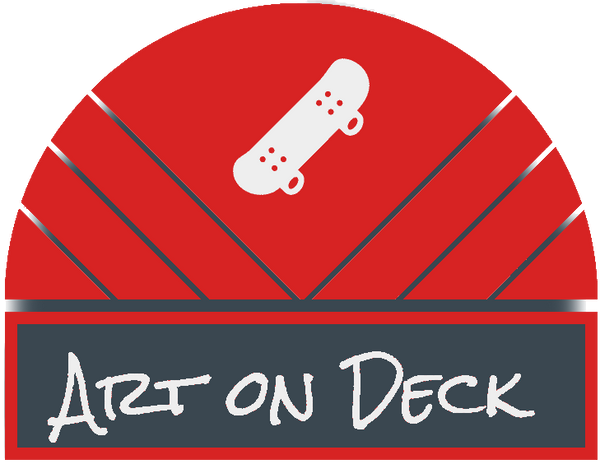
The Impact and Relevance of Skateboard Art
Share
|
Art
on Skateboards
The meaning or purpose behind the art found on skateboard decks can
be elusive for someone who has no connection to it. A consumer
who is shopping for a skateboard for their first time may not
have any idea who made the graphic, why it was designed, or what
the meaning behind it is - and that information is not typically
advertised, however the graphic is the first thing we see - we
are visually drawn to the imagery and if they speak to, or
resonate with the buyer, chances are they will gravitate towards
it. A more experienced rider will choose a board shape and size
that suits their style, preference, terrain, and individual
ability. It is also well understood and appreciated, that
the deck will be ridden, the graphic scratched up, and may even
be unrecognizable after a few skate sessions.
So what's in a graphic? What makes it special? Why even bother to
put art on a skateboard deck if it will get banged up and
scratched from use, or if the shape is actually more relevant
when it comes to actually riding it? One of the obvious answers
is - marketing. Understandably, in a competitive market, brands
need to showcase their unique identity and style, and the
easiest way to do this is through visual imagery. Another
important and often overlooked aspect of what makes skateboard
graphics special, are the memories and social connections they
create. Thinking back to the first skateboard I owned (a Santa
Cruz Jeff Grosso Acid Tongue, with Santa Cruz Bullet Wheels and
Independent Trucks), the graphic, or the memory of the graphic
if it had been scratched and later had become unrecognizable,
brings me back to that time in my life along with all of the
positive experiences and connections made.
A board graphic, especially the first one I ever owned, is forever
etched into my mind with associations of the good times I had
growing up, the late night skate sessions with my friends,
practicing on the mini-ramp in my father's shed which had
vert-like transitions, and the feeling of belonging with a group
of friends who were not into traditional team sports - and who
just wanted to skate. Skateboarding gave us the freedom to be
ourselves without the constraint of rule-based sports, as we
could do it on our own time, to be the beat of our own drum.
Nobody was telling us we had to do it a certain way, we could
each have our own individual styles, levels of ability, and we
could choose the board and graphic we wanted - the one that
spoke to us as individuals. Acquiring a new pro deck was
exciting, knowing you could try out a new shape and style, and
ride it with pride during the next skate session. Friends would
get excited too, and it allowed for a sense of pride to have
whatever it was - the latest Powell Peralta, or Santa Cruz
board. Every new skateboard model I acquired can be associated
with friends, times and places in the past - and whilst the deck
shape and size became more important as my experience level
rose, the graphic was always a huge part of shaping my memories
and experiences.
A skateboard graphic also helps to identify and recall the board
itself - how it felt to ride, what characteristics it had, and
how it helped me learn and progress in my skateboarding journey.
I had a mini Powell Peralta Ray Underhill Cross and Chains deck,
and recall how light and easy it was to ollie with, and I will
never forget the larger and wider SIMS Eric Nash Pumpkin
scratch-off graphic deck that I rode which for some reason gave
me the ability to ollie much higher than I had ever been able to
before. Then there was the Steve Caballero Chinese Dragon board,
which just didn't work well for me as it seemed heavier and
harder to do tricks on. My younger brother's Lester Kasai Street
Cleaner board had the most amazing pop making ollies effortless.
All of these nuances and characteristics of the boards, how they
felt, how they rode, who I rode the boards with, and how they
helped me improve and grow my skills, can all be tied back to
the graphic - because that's the easiest and most recognizable
identifier. So it is accepted that the graphic is meant to be
scratched up, and the shape is what really matters at the end of
the day - however the art on the skateboard deck carries
significant relevance and importance in skateboarding culture,
and generally in a societal context where visual stimuli can
create strong and meaningful connections and memories.
One of the main goals of Art on Deck is to showcase skateboard art
and uncover the meaning and purpose behind the graphics - who is
the artist or designer making it, why did they make it, what
inspired them, what/who do they want to inspire, and why did
they choose for it to be on a skateboard instead of say a
traditional medium like paint on paper? So I am on a mission to
meet skateboard artists, find out what drives them to make
skateboard art, uncover the meaning and purpose behind their
art, to delve into the mechanisms and thoughts behind the
creative process, and to share this with others with the hopes
of creating a deeper level of understanding and appreciation for
skateboard art.
To that end, I hope you will check out my Artists blog at Artists – Art on Deck,
where I am gradually adding new artist profiles, interviews,
images, stories and experiences of traditional visual artists who
have worked on skateboards as a medium, and artists who primarily
specialize in designing and creating skateboard art.
__________________
|
